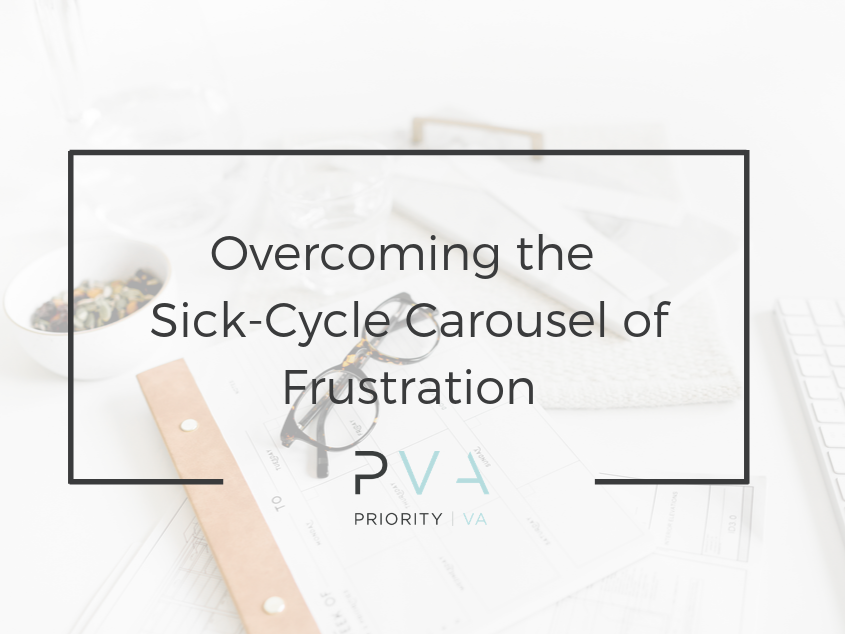As a leader, it’s important to empower your team. An empowered team will own their roles and enable you to outsource confidently, so you can spend more time doing the work you love.
Letting go of the work you have to do, to make room for the work you love to do, is a big transition.
It’s one that requires trust.
Many business owners struggle to trust their team with outcomes because they think they won’t deliver with their same quality of work.
Unfortunately, operating with this belief results in an unhealthy cycle that kills business productivity and team empowerment.
We call this cycle the Sick-Cycle Carousel.
At its core, the Sick-Cycle Carousel (SSC) is the effect of a business leader operating without a trusted team.
The cycle is this:
- When a business leader doesn’t have a team they can trust, they get frustrated. They are frustrated because work isn’t being done the way they expected it would be. They then wonder why their team doesn’t “get it.”
- This frustration leads to a desire for control. Leaders will take work back that they had originally delegated to ensure it is done “correctly” or to their standards.
- When the leader has taken back control of business outcomes, they react. They lash out, and become angry or passive aggressive with their team.
The more the business owner takes back, the more frustrated they become, the more they lash out, and the Sick-Cycle Carousel continues.
The cycle is Frustration equals Control equals React.
A leader cannot operate this way and expect to reap success.
The SSC creates a volatile and vulnerable work environment for a team. They may feel like they are walking on eggshells with their leader, or confused as to why they are treated passive aggressively. They also may be blamed for everything that goes wrong.
The only way to overcome the SSC is to stop the cycle.
Before you learn how to overcome the SSC, it’s important to understand what got you to this point. It requires looking inward.
Frustration
Feeling frustrated toward your team and constantly thinking that they don’t “get it” can come from a lot of different places.
Ask yourself: are people serving in the best role suited for them? Was someone hired hastily and not set up for success? Do your new hires align with the culture you are trying to create? And most importantly… with your vision and values?
It’s common for new entrepreneurs to hire people quickly to get help fast, but then they feel frustrated that these team members don’t work out in the long run. This is caused by not knowing WHO you want, and instead only focusing on WHAT you want done.
If your issue is rooted in hiring problems, either revise your approach to hiring, or change the way you engage with your new hires.
If you feel you have the right people in the right seats, and that people embody the values of the organization, the frustration may come from a lack of process.
Are processes and protocols mapped out and documented, so team members can follow your standards accurately? Have you defined what success looks like? Have you clearly communicated your expectations?
An effective leader will map out what success looks like, and give their team freedom to execute how they want — but only within the defined parameters.
Control
Taking back control as a leader may seem like a necessity when people don’t perform to your standards. You may even tell yourself you wish you weren’t taking back control, but that you must.
The “need” to take back control is often the result of a lack of willingness to lead.
Rather than investing in training and process development with their team, business owners revert to operating in a silo because it is a quick fix. They think it’s “just faster” if they do the work themselves.
They put themselves back into the driver’s seat when they should be empowering their team to come forward.
But this defeats the purpose of having a team! Leaders should want their team to work with them.
If you are new to delegating, or still haven’t found a rhythm with your team, remember that delegating takes time. It is not a set-and-forget activity. It requires training and effective communication about expectations and preferences.
You must put in the time to work together.
React
Rather than lash out at your team, it’s time to make a change.
The only way to break the SSC is to change your behavior. If this cycle is anything, it is an indication of your need to grow in a certain area.
All leaders must hold a mirror to themselves and analyze their strengths and shortcomings. The SSC is an opportunity for you to change unhealthy processes in your organization.
- Decide that you will break the cycle by committing to lead, teaching your team to think for themselves and letting people own their outcomes.
- Take stock of where you are and what you want as a leader and as an organization. Then create an actual system to attract, recruit, vet, train and retain amazing talent to put yourself on a healthy new path.
- Refine your system and process for bringing new hires into the fold and how you show up once they are hired. Is it sink or swim? Or do you actively engage with new hires to encourage, equip and empower them to do their best work?
Stopping the cycle takes intentionality and work but is well worth it for yourself, the health of your organization and the viability of your team.
If you’re interested in learning more about what an Executive Virtual Assistant can do for your business, schedule a strategy call with us. Our team will help you determine how your business can benefit from our Priority Executive VAs.





